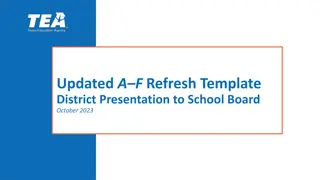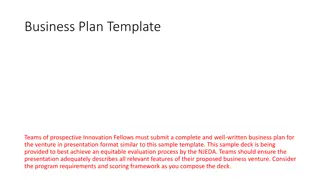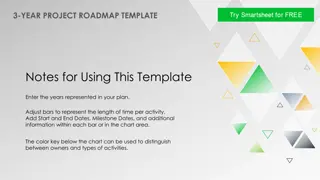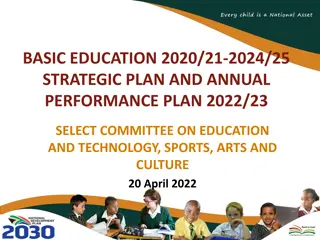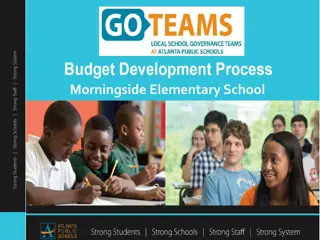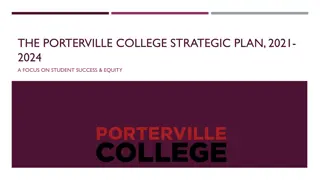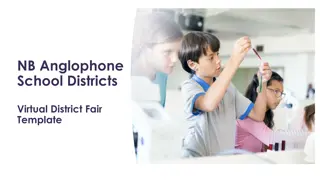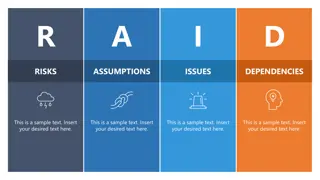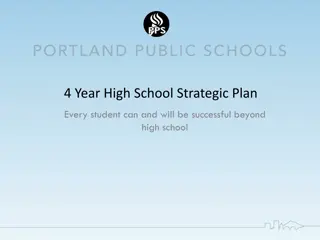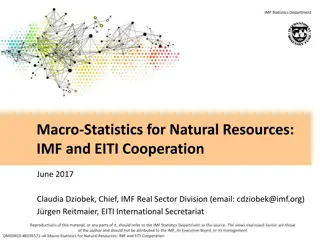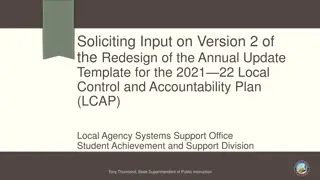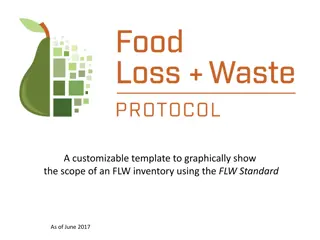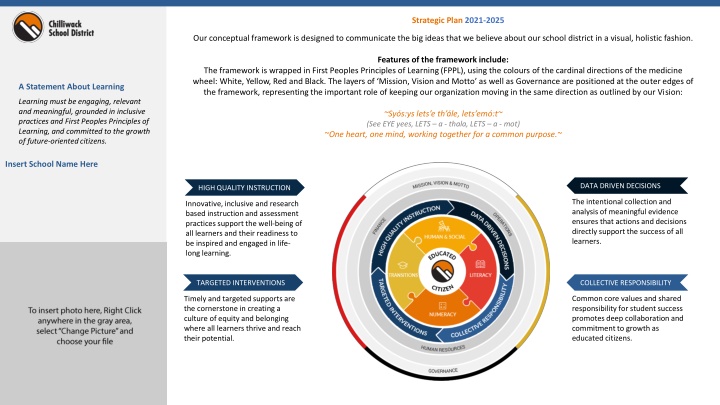
Holistic Framework for School District Success
Explore our strategic plan for 2021-2025, encapsulating First Peoples Principles of Learning in a visually engaging manner. Focused on data-driven decisions, high-quality instruction, literacy goals, and numeracy initiatives to ensure student success and well-being.
Uploaded on | 0 Views
Download Presentation

Please find below an Image/Link to download the presentation.
The content on the website is provided AS IS for your information and personal use only. It may not be sold, licensed, or shared on other websites without obtaining consent from the author. If you encounter any issues during the download, it is possible that the publisher has removed the file from their server.
You are allowed to download the files provided on this website for personal or commercial use, subject to the condition that they are used lawfully. All files are the property of their respective owners.
The content on the website is provided AS IS for your information and personal use only. It may not be sold, licensed, or shared on other websites without obtaining consent from the author.
E N D
Presentation Transcript
Strategic Plan 2021-2025 Our conceptual framework is designed to communicate the big ideas that we believe about our school district in a visual, holistic fashion. Features of the framework include: The framework is wrapped in First Peoples Principles of Learning (FPPL), using the colours of the cardinal directions of the medicine wheel: White, Yellow, Red and Black. The layers of Mission, Vision and Motto as well as Governance are positioned at the outer edges of the framework, representing the important role of keeping our organization moving in the same direction as outlined by our Vision: A Statement About Learning Learning must be engaging, relevant and meaningful, grounded in inclusive practices and First Peoples Principles of Learning, and committed to the growth of future-oriented citizens. ~Sy s:ys lets eth le, lets em :t~ (See EYE yees, LETS a - thala, LETS a - mot) ~One heart, one mind, working together for a common purpose.~ Insert School Name Here DATA DRIVEN DECISIONS HIGH QUALITY INSTRUCTION The intentional collection and analysis of meaningful evidence ensures that actions and decisions directly support the success of all learners. Innovative, inclusive and research based instruction and assessment practices support the well-being of all learners and their readiness to be inspired and engaged in life- long learning. TARGETED INTERVENTIONS COLLECTIVE RESPONSIBILITY Common core values and shared responsibility for student success promotes deep collaboration and commitment to growth as educated citizens. Timely and targeted supports are the cornerstone in creating a culture of equity and belonging where all learners thrive and reach their potential.
LITERACY GOALS We are dedicated to ensuring that students are proficient in foundational literacy skills and increase their abilities, confidence and willingness to engage with language to acquire, construct and communicate in meaningful ways from Early Learning Years (pre-K) through to Grade 5 1. We understand, plan and deliver instruction using competency-based curriculum (curricular competencies and content). School Actions School Measures Strategy To have students enjoy writing and feel confident as authors To build writing stamina To build common language in Writing by revisiting Yarrow s Scope and Sequence To use the ACT to enhance student engagement and understanding of reading. To implement One Book One School as a common reading experience To continue to build classroom libraries and have entry points for all readers; to ensure that just right texts are accessible for all students To continue with Early Intervention groups To continue to build on Question Techniques to engage all learners Tracking learners over time Using District Assessments Observations of individuals and small groups 2. We utilize competency- based assessments to assess student progress pre-K to grade 5. 3. We implement data driven, timely and targeted instructional interventions for students. District Measures FSA 4 (Reading / Writing) FSA 7 (Reading / Writing) Literacy 10 and 12 PM Benchmarks (running records) ACT (Assessment of Comprehension and Thinking)
NUMERACY Goal We are dedicated to ensuring that all students become proficient in numeracy skills that allow them to create, apply and conceptualize mathematics in real world situations from Early Learning Years (pre-K) through to Grade 5. 1. We understand, plan and deliver instruction using competency-based curriculum (curricular competencies and content). School Actions School Measures Strategy To continue to embed Fluency, Mental Math and Connections to student learning To use SNAP as an effective assessment tool To connect math to literature and the real world To use technology to complement math lessons To represent numbers in different ways, using manipulatives, games, songs and calendar. To continue using high yield routines; such as, Number of the Day, Number talks and Counting Collections. To balance hands on learning and paper/pencil work To continue to practice questions that provoke student engagement District Assessments Daily Observations Formative and Summative 2. We utilize competency- based assessments to assess student progress pre-K to Grade 5. 3. We implement data driven, timely and targeted instructional interventions for students. District Measures FSA 4 FSA 7 Numeracy 10 SNAP (Student Numeracy Assessment and Practice)
HUMAN AND SOCIAL DEVELOPMENT Goal We celebrate diversity, embrace inclusion and foster a sense of belonging to ensure all students thrive. Equity and inclusion are foundational to learning and leading, and are critical to success, wellbeing and fulfillment. 1. We understand, plan and deliver competency-based curriculum (curricular competencies and content) related to Social Emotional Learning and Mental Health Literacy. School Actions School Measures Strategy To continue to create opportunities for school wide projects that tie directly to the Core Competencies To make strong connections to Positive Behavior System, using the Six Cedars as a starting point To utilize district staff to enhance teaching practices To continue to create opportunities to make learning fun and engaging through culture and school wide events. To use the Story and Art studios to provide opportunities that elicit a starting point for all learners. To use school wide language such as the Zones of Regulation to regulate the community. To continue to use the local environment and community for place-based learning opportunities To explore connections with local Indigenous people and invite them to share their knowledge Attendance Achievement scores District assessments 2. We commit to truth, reconciliation and healing to address the inequity of outcomes for Indigenous learners. We address unconscious bias, systemic discrimination and marginalization to transform district culture. 3. We provide supports for the well- being of all learners. District Measures Student Learning Survey grade 4, 7, 10 and 12 EDI (Early Years) CHEQ (Kindergarten) MDI (Middle Years) BCAHS (BC Adolescent Health Survey) YDI (Secondary Years)
TRANSITIONS Goal Students experience pivotal transition points throughout their education, from pre-K to Kindergarten, from grade to grade, school to school, and from school to post-secondary or work situations. We acknowledge our responsibility to support all learners, so they successfully complete their education (pre-K through to Grade 5) with a sense of dignity and purpose, and opportunities to meet their goals. 1. We target early years learning to ensure students are well supported during their transition to Kindergarten, throughout their elementary years and to middle school. School Actions School Measures Strategy School based team/Core KLST District Assessments To continue with Core team meetings to discuss student learning and address the needs of at-risk students To continue to support our early learners through our K-1 Intervention time Continue with Tier 2 groups that support pre and early literacy skills such as Talking Tables and Moe the Mouse To track students from year to year To provide extra supports for at-risk students 2. We utilize developmentally appropriate practices through early years to foster growth and get students ready for the adolescent years. 3. We ensure students are engaged in their learning 4. Find meaningful pathways, throughout secondary school and beyond graduation, including post- secondary, apprenticeship, college and workplace. District Measures Grade to Grade Transition Data 5 and 6 Year Completion Rates (Graduation) Post-Secondary Transition Rates Attendance Rates


